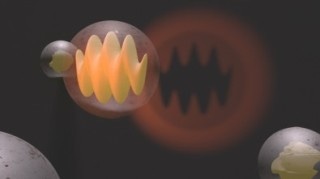Oct 17 2019
Information is nothing but energy. Therefore, for quantum information development, the main objective is to increase the time during which a system can retain energy before it is lost to the local environment.
 Research reported in Physical Review Letters presents the detection of energy transfer from excited electrons to the crystal lattice on the femtosecond timescale. Knowledge could contribute to the development of materials that prolong the coherence time (illustration represents interaction between excitons and phonons). (Image credit: FAPESP)
Research reported in Physical Review Letters presents the detection of energy transfer from excited electrons to the crystal lattice on the femtosecond timescale. Knowledge could contribute to the development of materials that prolong the coherence time (illustration represents interaction between excitons and phonons). (Image credit: FAPESP)
This time interval is known as the “coherence time.” Many studies have focused on decreasing decoherence.
A study by scientists at the Gleb Wataghin Institute of Physics (IFGW-UNICAMP), University of Campinas, São Paulo State, Brazil, in collaboration with colleagues at the Physics Department, University of Michigan, Ann Arbor, USA, and Advanced Institute of Nanotechnology (SAINT SKKU), Sungkyunkwan University, Seoul, South Korea, aimed to gain insights into the decoherence process on the femtosecond (10−15 s, or one-quadrillionth of a second) timescale.
The study findings have been reported in Physical Review Letters.
In this research, exciton–phonon interactions were observed on the femtosecond timescale. An exciton is an excited electron, and a phonon is a quantum unit of vibrational energy in a crystal lattice.
The research was successfully carried out using a new ultrafast spectroscopy method with high temporal and spectral resolution. The study was supported by FAPESP through a Young Investigator Grant awarded to Lázaro Aurélio Padilha Junior and a project conducted together with the University of Michigan within the framework of the FAPESP program São Paulo Researchers in International Collaboration (SPRINT).
Padilha was one of the principal investigators of the study. Diogo Burigo Almeida, then a postdoctoral fellow at Michigan, was one of the study lead authors. The experiment was done using semiconducting nanocrystals dispersed in a colloidal solution at cryogenic temperatures.
We found that when the material is excited [by light], the light it emits changes color in under 200 femtoseconds. This is due to interaction between excitons and phonons. The excitons transfer part of the energy they receive to the crystal lattice. This causes a change of frequency and hence a change of emission color.
Lázaro Aurélio Padilha Junior, Study Principal Investigator, FAPESP
For the first time, they observed this phenomenon in the study.
He added, “It had never been observed before because the amount of energy transferred from each exciton to the lattice is tiny, corresponding to 26 millielectron volts (26 × 10−3 eV), and the process takes a very short time, lasting under 200 femtoseconds (200 × 10−15 s). Similar phenomena have been observed but on far greater timescales and due to other processes. We accessed hitherto unknown physical relations.”
For a long time, he and his research team had been studying semiconductor nanomaterials with sizes ranging from 1 to 10 nm. An important challenge while inducing the growth of these materials is that each of these individual units grows differently.
Therefore, the light spectrum emitted by the material following excitation is extended, with the different components emitting at somewhat different frequencies, and with the color of the emission less accurate. The isolation of a single particle makes the spectrum narrower but hinders signal detection. Simply put, spectral resolution is improved but at the loss of temporal resolution.
About five years ago we began working with a technique that can pick out subsets comprising a few thousand identical particles from a set of 1020 nm particles. This has enabled us to achieve very fine and precise spectral resolution, as well as fine temporal resolution. In this study, we obtained single-particle spectral resolution for a group of particles in an exceptionally short time.
Lázaro Aurélio Padilha Junior, Study Principal Investigator, FAPESP
This experimental result helped the scientists to access earlier unknown physical processes, like the interaction between ultrafast excitons and phonons. In condensed matter physics, a noteworthy fact is that the phonon is a quasi-particle related to the quantum of vibration that can propagate in a crystal lattice.
Currently, there are no technological uses for the derived findings. However, in the near future, knowledge of physical interactions on the femtosecond timescale can assist researchers to control the structure of the materials so that excitons can retain energy from light or electrical impulses for a prolonged period, decreasing decoherence in quantum systems.
Prolonging coherence is key to the success of devices such as optical switches and single-photon emitters. Actually, what you aim to do is reduce energy waste to a minimum. When the material changes color, it means it’s losing energy. We discovered that this loss is extremely fast. That’s what we want to delay.
Diogo Burigo Almeida, Study Lead Author, University of Michigan